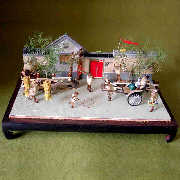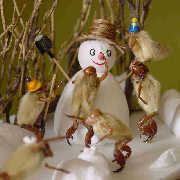 When talking about hairy monkeys, young people of today usually have no idea what they are and tend to think of them as a kind of monkeys, like the white monkeys and macaques. Actually, hairy monkeys are a kind of folk handicraft of old Beijng. The body of these delicate ten-by-five millimeter toys is made from white Magnolia bud and shed cicada skin (as the doll's head and limbs), and because these handicrafts look a lot like monkeys, they are hence named "hairy monkey".
When talking about hairy monkeys, young people of today usually have no idea what they are and tend to think of them as a kind of monkeys, like the white monkeys and macaques. Actually, hairy monkeys are a kind of folk handicraft of old Beijng. The body of these delicate ten-by-five millimeter toys is made from white Magnolia bud and shed cicada skin (as the doll's head and limbs), and because these handicrafts look a lot like monkeys, they are hence named "hairy monkey".
With an air of charming naivety, the hairy monkeys are enormously popular among old Beijingers. However, for various reasons, the folk art is facing extinction, as in today's Beijing, only several artists are well acquainted with the techniques of making hairy monkeys.
The creation of hairy monkeys was quite an accident. In the late Qing Dynasty (1644-1911), there was a drug store named "South Qingren Hall". One day, two assistant chemists in the store, while fiddling with some Chinese medicine, worked out a small monkey-like toy with a shed cicada skin, a hairy white magnolia bud, a bletilla striata (the stem of a kind of plant) and an akebi (another kind of plant).
 Their accidental creation caught the attention of the shopkeeper, who then suggested selling the four Chinese medicines in a pack as raw materials for making such toys. Hairy monkeys then became popular as a folk handicraft, but were limited among the small number of folk artists and the banner men ("Banners" is the military organization of the Qing Dynasty).
Their accidental creation caught the attention of the shopkeeper, who then suggested selling the four Chinese medicines in a pack as raw materials for making such toys. Hairy monkeys then became popular as a folk handicraft, but were limited among the small number of folk artists and the banner men ("Banners" is the military organization of the Qing Dynasty).
Though the raw materials are quite simple, the artists are capable of designing exquisite patterns through their observation and perceptual knowledge of a wide range of images. By using the hairy magnolia bud as the body, and adhering the head and claws cut from the cicada to it, they can create artworks of various kinds of shapes and postures.
Modeled on human actions and scenes from daily life, the handicrafts vividly represent urban life and customs, like barbers, fortune-tellers, hawkers of sugarcoated haws on a stick and so on. Some of the handicrafts form a complete set of artworks, such as "The County Magistrate on Inspection," and "Marriage Series," which were sometimes available at the stalls of temple fair and in the Dong'an Market as well as some toyshops in Quanye Department Store. In recent years, additional creations of this handicraft, which, while sticking to the traditional subjects, also reflects the real modern life.
